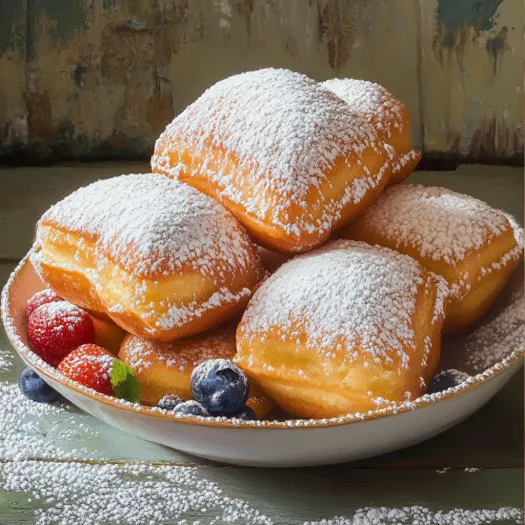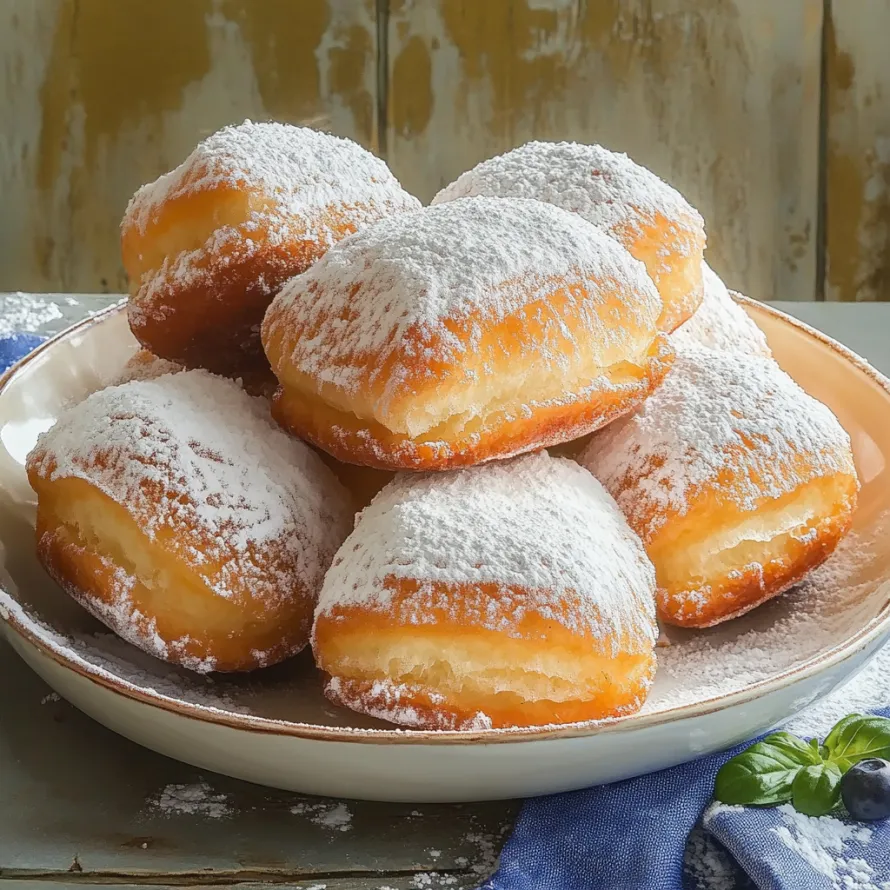 Save
Save
These fluffy French pastry puffs turn everyday kitchen ingredients into soft, golden clouds covered in powdered sugar. They're so airy and light they'll bring a bit of New Orleans magic to your home without much work but tons of enjoyment.
I first whipped these up during a Mardi Gras party, and they vanished before I could even finish dusting them. They've now become what we crave on Sunday mornings when we want something fancy without messing with yeast doughs.
What You'll Need
- All purpose flour: Makes the base of your pastries, giving them shape while keeping them soft
- Baking powder: Creates that wonderful puff when they hit the hot oil
- Salt: Brings out all the tastes and cuts through the sweetness
- Granulated sugar: Adds just the right touch of sweetness to the mix
- Large egg: Holds everything together and makes them rich
- Vanilla extract: Gives a warm, lovely smell and taste in every bite
- Whole milk: Makes the dough tender - try to use full fat for best results
- Unsalted butter: Adds a rich taste and helps them turn golden brown
- Vegetable oil: For cooking; pick one that won't smoke easily
- Powdered sugar: For that classic sweet coating; don't hold back when dusting
How To Make Them
- Mix Your Dry Stuff:
- Grab a big bowl and stir the flour, baking powder, salt, and sugar together until they're well mixed. This helps your pastries rise evenly and taste good all the way through. Break any flour lumps for the smoothest dough possible.
- Blend Wet Ingredients:
- In another bowl, beat the egg a bit, then pour in vanilla, milk, and melted butter. Make sure the butter's warm but not hot so it won't cook the egg. Stir until everything looks smooth with a slight shine from the butter.
- Put Everything Together:
- Pour your wet mix into the dry stuff and stir with a wooden spoon. Mix just until you don't see dry patches and the dough comes together. Don't go overboard with mixing or your pastries will get tough. Your dough should pull away from the bowl sides but feel soft and a bit sticky.
- Get Your Oil Hot:
- Pour oil into a deep pan about 2 inches deep. Heat it to 350°F, checking with a thermometer if you can. Getting this right matters a lot - too cold and they'll soak up oil and get soggy; too hot and they'll burn outside while staying raw inside.
- Cook The Pastries:
- Scoop some dough with a tablespoon and drop it carefully into the hot oil. Don't crowd the pan - cook 4 or 5 at a time. They'll start puffing up right away. Let them cook about 2-3 minutes on one side until golden brown, then flip and cook another 2 minutes until they're evenly browned.
- Dry And Coat:
- Lift them out with a slotted spoon onto paper towels to soak up extra oil. While they're still hot, shake lots of powdered sugar over them using a small strainer. The heat helps the sugar stick better to the surface.
- Time To Eat:
- Put them on a plate and eat them right away while warm. They go great with coffee, especially café au lait, or hot chocolate for a real French touch.

The vanilla is really the hidden gem here. Many folks just use a tiny bit, but I found using a whole teaspoon creates this amazing smell that turns these simple treats into something special. My grandma always told me good vanilla changes everything when you're baking, and these pastries prove she was right every single time.
Getting Oil Just Right
Keeping your oil at the right heat is probably the biggest secret to making these turn out amazing. If it's not hot enough, they'll soak up too much oil and end up heavy and greasy. Too hot, and they'll burn outside while staying doughy inside. I suggest using a candy thermometer clipped to your pot to watch the temperature. After cooking each batch, wait a minute for the oil to get back to 350°F before adding more dough. This steady temperature gives you that perfect golden outside with a light, fluffy inside.
Do Some Prep Beforehand
Though these taste best right after cooking, you can get things ready ahead of time to make it easier. You can mix the dry stuff and keep it in a sealed container for up to a month. The complete dough can be mixed, wrapped tight, and kept in the fridge for a day. Just let it warm up for about 30 minutes before cooking. I often make the dough the night before a special breakfast, which makes morning cooking quick and easy while still giving that freshly made feeling.
Try Different Flavors
The basic vanilla version is wonderful, but you can play around with this recipe. Try adding lemon or orange zest for a bright flavor. A bit of cinnamon or nutmeg in the dough adds warm, cozy notes perfect for fall get-togethers. If you love chocolate, toss in some mini chocolate chips just before cooking for gooey bits of sweetness. My favorite twist is adding 1/2 teaspoon of almond extract with the vanilla, which gives them a fancy bakery taste just like in French pastry shops.

Enjoy these golden, fluffy treats while they're warm and fresh for an amazing snack that'll make you feel like you're sitting in a New Orleans café.
Common Recipe Questions
- → Can I make the beignet dough ahead of time?
You can definitely make the dough up to a day early and keep it in your fridge wrapped tight. Just let it sit out for about 30 minutes to warm up before you start frying them.
- → Why did my beignets turn out dense instead of fluffy?
Your beignets might be dense because you mixed the dough too much or your oil wasn't hot enough. Just mix until everything comes together and make sure your oil stays around 350°F the whole time you're cooking.
- → Can I use a different type of milk?
Whole milk gives you the best flavor and texture but you can try 2% milk or plant milks like almond or oat. Just know your beignets will taste a bit different with each kind.
- → How do I know when the oil is at the right temperature?
If you don't have a food thermometer, try dropping a tiny bit of dough in the oil. It should bubble up right away and float to the top but not get dark too fast. Good beignets need about 2-3 minutes on each side to turn nice and golden.
- → How long do beignets stay fresh?
Beignets taste way better when you eat them right after cooking while they're still warm. You can keep them in a sealed container for a day or two at room temperature but they won't be as crispy. Pop them in a 300°F oven for a few minutes to make them crisp again.
- → Can I freeze the beignet dough?
You can freeze the dough for up to a month. Cut it into portions before freezing then let it thaw completely in your fridge when you want to use it. Make sure it warms to room temperature before you fry it.
